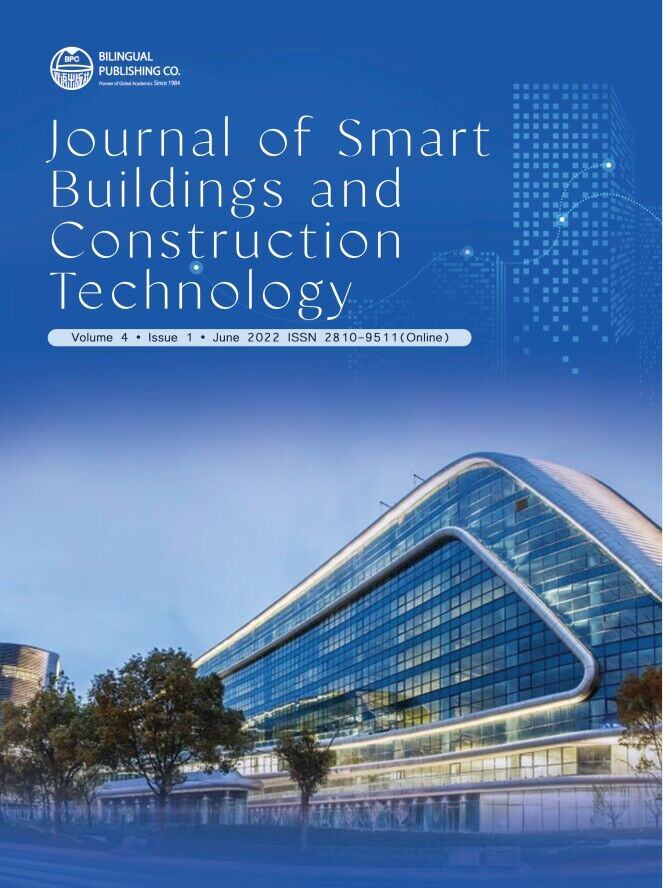-
163
-
146
-
121
-
120
-
89
Evaluation and Simulation of the Effect of the Types of Glazing and the Choice of Materials on the Energy Efficiency of a Building
DOI:
https://doi.org/10.30564/jsbct.v4i1.4790Abstract
Tunisia is one of the pioneering developing countries in terms of energyefficiency policy initiated since the mid-1980s. Indeed, energy efficiencyhas become one of the main pillars of the country’s energy strategy,especially with the increase in energy prices. The main objective of thiswork is to give an idea of the impact that certain choices made during thedesign of a building can have on its energy balance, namely the orientationof the facades, the types of glazing and their surfaces, the choice ofmaterials, etc. The calculation of the building’s energy requirement wasdetermined using the transient systems simulation program TRNSYS(version 18) with a modular structure.Keywords:
Energy efficiency; Energy requirement; Building; Orientation; Simulation; TRNSYSReferences
[1] BPIE, 2011. Buildings performance institute Europe. Europe’s buildings under the microscope.
[2] Heo, Y., Choudhary, R., Augenbroe, G.A., 2012. Calibration of building energy models for retrofit analysis under uncertainty. Energy Building. 47, 550e60.
[3] Goulding, J., Lewis, O., Steemers, T., (Eds.), 1992. Energy in Architecture: The European Passive Solar Handbook, Batsford for the Commission of the European Communities.
[4] Jermyn, D., Richman, R., 2016. A process for developing deep energy retrofit strategies for single-family housing typologies: three Toronto case studies. Energy Building. 116, 522e34.
[5] International Energy Agency (IEA), 2015. http://www.iea.org/newsroomandevents/pressreleases/2015/november/low-prices-should-give-no-causefor-complacency-on-energy-security-iea-says.html.
[6] Alwetaishi, M., Benjeddou, O., 2021. Impact of Window to Wall Ratio on Energy Loads in Hot Regions: A Study of Building Energy Performance. Energies. 14, 1080. DOI: https://doi.org/10.3390/en14041080
[7] Alwetaishi, M., Taki, A., 2020. Investigation into energy performance of a school building in a hot climate: Optimum of window-to-wall ratio. Indoor Built Environ. 29, 24-39.DOI: https://doi.org/10.1177/1420326X19842313
[8] Lee, J.W., Jung, H.J., Park, J.Y., et al., 2013. Optimization of building window system in Asian regions by analyzing solar heat gain and daylighting elements. Renewable Energy. 50, 522-531. DOI: https://doi.org/10.1016/j.renene.2012.07.029
[9] Bouden, C., Ghrab, N., 2005. An Adaptive Thermal Comfort Model for the Tunisian Context : A Field Study Results. Energy and Buildings. 37(9), 952-963.
[10] Su, X., Zhang, X., 2010. Environmental performance optimization of window-wall ratio for different window type in hot summer and cold winter zone in China based on life cycle assessment. Energy and Buildings. 42, 198-202.DOI: https://doi.org/10.1016/j.enbuild.2009.08.015
[11] Bouchlaghem, N., 2000. Optimising the design of building envelopes for thermal performance, Automation in Construction. 10, 101-112.DOI: https://doi.org/10.1016/S0926-5805(99)00043-6
[12] Bouchlaghem, N., 2000. Optimising the design of building envelopes for thermal performance. Automation in Construction. 10, 101-112. DOI: https://doi.org/10.1016/S0926-5805(99)00043-6
[13] Alwetaishi, M., 2019. Impact of glazing to wall ratio in various climatic regions: A case study. Journal of King Saud University. Engineering Science. 31, 6-18. DOI: https://doi.org/10.1016/j.jksues.2017.03.001
[14] Ben-Nakhi, A.E., 2002. Minimizing thermal bridging through window systems in buildings of hot regions. Applied Thermal Engineering. 22, 989-998. DOI: https://doi.org/10.1016/S1359-4311(01)00121-1
[15] Cesari, S., Valdiserri, P., Coccagna, M., 2016. The Energy Saving Potential of Wide Windows in Hospital Patient Rooms, Optimizing the Type of Glazing and Lighting Control Strategy under Different Climatic Conditions. Energies. 13, 2116. DOI: https://doi.org/10.3390/en13082116
[16] Khoukhi, M., Darsaleh, A.F., Ali, S., 2020. sustainability Retrofitting an Existing Office Building in the UAE Towards Achieving Low-Energy Building. Sustainability. 12, 2573. DOI: https://doi.org/10.3390/su12062573
[17] University of Wisconsin-Madison, Solar Energy Laboratory, TRANSSOLAR Energietechnik GmbH, CSTB, and TESS, TRNSYS User’s Manual, a TRaNsient SYstem Simulation program, 16 ed., 2006.
[18] Hachem, C., Athienitis, A., Fazio, P., 2011. Parametric investigation of geometric form effects on solar potential of housing units. Solar Energy. 85(9), 1864-1877.
[19] Bichiou, Y., Krarti, M., 2011. Optimization of envelope and HVAC systems selection for residential buildings. Energy Building. 43(12), 3373-3382.
[20] NF EN 410, 2011. Glass in construction - Determination of the luminous and solar characteristics of glazing.
[21] CIBSE, 2013. Lighting Guide 9: Lighting for communal residential buildings.
[22] NF EN 13363-2, 2005. Solar protection devices combined with glazing - Calculation of total solar energy transmittance and light transmittance - Part 2 : detailed calculation method.
[23] Singh, M.C., Garg, S.N., 2009. Energy rating of different glazings for indian climates. Energy. 34(11), 1986-1992.
[24] Cheung, C.K., Fuller, R.J., Luther, M.B., 2005. Energy Efficient Envelope Design for High Rise Apartments. Energy and Building. 37(1), 37-48.
[25] Cheng, V., Ng, E., Givoni, B., 2004. Effect of Envelope Colour and Thermal Mass on Indoor Temperatures in Hot Humid Climate. Solar Energy. 4, 528-534.
[26] Somasundaram, S., Thangavelu, S.R., Chong, A., 2016. Effect of Existing Façade’s Construction and Orientation on the Performance of Low-E-Based Retrofit Double Glazing in Tropical Climate. Energies. 13.
Downloads
How to Cite
Issue
Article Type
License
Copyright © 2022 Malek Jedidi

This is an open access article under the Creative Commons Attribution-NonCommercial 4.0 International (CC BY-NC 4.0) License.




 Sami Yaich
Sami Yaich





